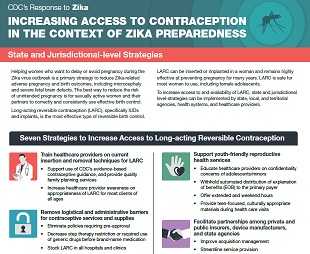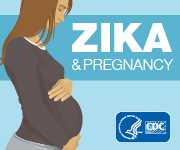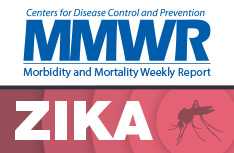Reproductive Planning
A reproductive life plan helps a woman think about her goals for having or not having children and how to achieve these goals. A woman’s plan depends on her personal goals. Reproductive life plan worksheets are available here.
Offering family planning services, including information and access to the full range of contraceptive methods, is a primary strategy to reduce the number of unintended pregnancies affected by Zika virus infection.
Preconception Care
Preconception health care aims to promote the health of women of reproductive age before conception and to improve pregnancy-related outcomes. Because Zika virus infection is a cause of microcephaly and other severe fetal brain defects, it is very important that women and their partners residing in areas with risk of Zika consider if now is the right time to become pregnant. Healthcare providers should discuss reproductive life plans, including pregnancy intentions and timing with women of reproductive age. Decisions about pregnancy planning are personal. Decisions about attempting conception should be made in consultation with a healthcare provider.
If a decision is made that now is the right time to attempt conception, healthcare providers should emphasize the importance of protection against Zika virus infection during pregnancy for both the woman and her partner. As part of the planning process, women and their partners should discuss the risks of local Zika virus transmission with their healthcare providers. This discussion should include:
- An assessment of the risk of Zika exposure, including the presence of mosquitoes in and around the home, protective measures practiced, and levels of local transmission of Zika.
- Signs and symptoms of Zika.
- Possible adverse outcomes of Zika virus infection during pregnancy, including birth defects.
- Factors that might influence timing of pregnancy: fertility, age, reproductive history, medical history, and personal values and preferences.
Taking protective measures has been demonstrated to reduce the risk of vector-borne diseases; however, it might be impossible to eliminate the risk of Zika virus exposure during conception or pregnancy. The decision about timing of pregnancy is a personal decision and should be made by the person or couple in consultation with a healthcare provider.
Preventing Pregnancy
For women who want to delay or avoid pregnancy, healthcare providers should ensure access to safe and effective contraceptive methods that best meet their needs. Women and their partners who do not want to attempt conception now should use the most effective birth control method correctly and consistently. Using condoms the right way, every time can also reduce the risk of sexually transmitted diseases, including Zika.
Patients should be counseled about contraceptive methods, including the availability and effectiveness of different contraceptive methods and how to use these methods. The decision about what type of contraceptive method to use is a personal decision and should be made by the person or couple in consultation with their healthcare provider.
Long-acting reversible contraceptive methods, specifically intrauterine devices and implants, are the most effective reversible methods for preventing pregnancy. These methods are just as effective at preventing pregnancy as permanent methods, including tubal sterilization and vasectomy. Further information is available at CDC’s Contraception and CDC’s Contraceptive Guidance for Healthcare Providers webpages.
Condoms should be used to prevent sexual transmission of Zika, if the partner has had possible Zika virus exposure or Zika virus disease.
Clinician Resources
CDC has contraceptive guidance for healthcare providers that may be used when counseling patients about contraceptive choice, how to use contraceptive methods, and how to manage problems with contraceptive use. Information about the guidance, links to more information, and tools to help providers implement the guidance are provided below.
- The US Medical Eligibility Criteria for Contraceptive Use (US MEC) focuses on who can safely use specific methods of contraception, and provides recommendations for the safety of contraceptive methods for women with various medical conditions (such as hypertension and diabetes) and characteristics (such as age, parity, and smoking status). Several US MEC provider tools are available to help implement the US MEC.
- The Selected Practice Recommendations for Contraceptive Use (US SPR) provides guidance on how contraceptive methods can be used and how to remove unnecessary barriers for patients to successfully use contraceptive methods. Several provider tools are available to help implement the US SPR.
- Providing Quality Family Planning Services provides guidance on how to provide family planning and contraceptive counseling services. For more information about tools to help healthcare providers implement the recommendations, visit Family Planning National Training Centers.
CDC also developed teen pregnancy prevention tools for healthcare providers, including ideas to make clinics adolescent-friendly and recommendations on how to implement CDC’s evidence-based guidance in their practices.
Related Resources

Increasing Access to Contraception in the Context of Zika Preparedness
More Information
- Page last reviewed: April 25, 2017
- Page last updated: August 30, 2017
- Content source:





 ShareCompartir
ShareCompartir